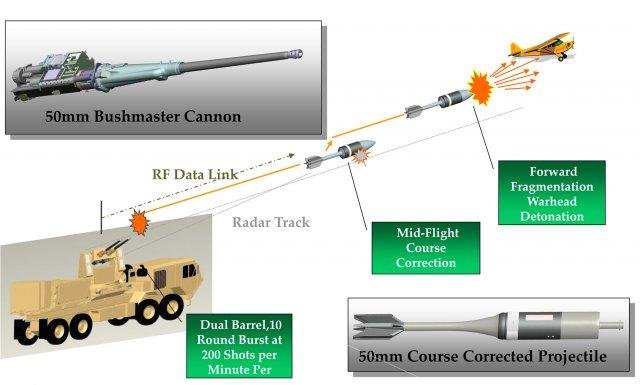Picatinny Arsenal demonstrates innovative technology to counter potential airborne threats 21407153
|
|
|||
|
Military Defense Industry Technology - US Army EAPS ID Demonstrator
|
|||
|
|
|||
| Picatinny Arsenal demonstrates innovative technology to counter potential airborne threats | |||
|
Picatinny Arsenal, the US Army's Joint Center of Excellence for Armaments and Munitions, recently demonstrated a new weapon system: the Extended Area Protection and Survivability Integrated Demonstration, or EAPS ID, which began as an Army Technology Objective program. The goal was to develop and demonstrate technology, which could support a gun-based solution to counter rockets, artillery and mortars, or C-RAM.
|
|||
|
|
|||
 Picatinny Arsenal's Extended Area Protection and Survivability system concept Picatinny Arsenal's Extended Area Protection and Survivability system concept |
|||
|
|
|||
|
Research into enhanced C-RAM technology had the goal of extending the range and probability of success against the incoming threat.
"The smaller and smaller the protective area, the more efficient the gun systems become compared to missiles," said Manfredi Luciano, the project officer for the EAPS system. "You don't need as many, and the gun system has certain logistics advantages." As news reports about potential airborne threats to the White House have stirred public awareness of such threat to U.S. interests, ongoing technology aimed at countering rockets, artillery and mortars could be used to defend against unmanned aerial systems, or UAS, Luciano said. "It's unbelievable how much it's exploded," Luciano said about the use of drones. "Every country has them now, whether they are armed or not or what level of performance. This is a huge threat has been coming up on everybody. It has kind of almost sneaked up on people, and it's almost more important than the counter-RAM threat." The UAS challenge has grown exponentially in the last decade as the world's inventory of Unmanned Aircraft Systems has grown from approximately 20 system types and 800 aircraft in 1999, to more than 200 system types and approximately 10,000 unmanned aircraft in 2010, said Nancy Elliott, a spokeswoman with the U.S. Army's Fires Center of Excellence on Fort Sill, Oklahoma. Although a missile-based C-RAM defense system has been selected as the technical approach for the Indirect Fire Protection Capability Increment 2 Intercept Program of Record, the gun alternative continued to mature as force-protection technologies for other potential applications. In response to proliferation, UAS threats recently were added to the project scope of gun-based force protection. Luciano and his team, working on enhanced area protection and survivability, tested an integrated system, April 22, by shooting down a class 2 unmanned aerial system using command guidance and command warhead detonation at Yuma Proving Ground, Arizona. Funding for development and testing was provided by the U.S. Army Armament Research, Development and Engineering Center, or ARDEC, Technology Office. The EAPS ARDEC gun alternative envisions a 50mm cannon to launch command guided interceptors. The system uses a precision tracking radar interferometer as a sensor, a fire control computer, and a radio frequency transmitter and receiver to launch the projectile into an engagement "basket." "In order to minimize the electronics on board the interceptor and to make it cheaper, all the 'smarts' are basically done on the ground station," Luciano said. "The computations are done on the ground, and the radio frequency sends the information up to the round." The Picatinny area-protection systems track both the incoming threat and interceptor, then compute an ideal trajectory correction for the interceptor to maximize probability of mission success. A thruster on the interceptor/projectile is used for course correction. The ground station uplinks the maneuver and detonation commands while receiving downlinked assessment data. The interceptor takes the commands and computes the roll orientation and time to execute thruster and warhead detonation. The warhead has a tantalum-tungsten alloy liner to form forward propelled penetrators for defeat of C-RAM targets, and steel body fragments to counter unmanned aerial systems. The April 22, 2015, test was performed with a single shot Mann barrel. The UAS was flying a surveillance-type track and was engaged on the approach path leg. The airplane fell precipitously from its flight. The integrated test demonstrated a proof-of-principle that direct fire, command guided ammunition can intercept and negate aerial threats, Luciano said. Technologies from the EAPS gun alternative Army Technology Objective may potentially be used for both Army and Navy air defense systems, he added. Luciano said that during another upcoming test, the engineers would try to intercept and destroy an unmanned aerial system under a more difficult engagement scenario. |
|||


























